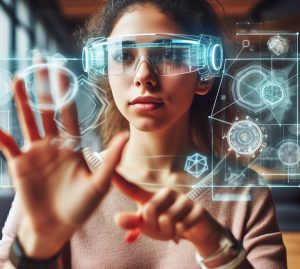The future path of augmented reality is a fascinating topic that involves many aspects of technology, society, and human experience. Augmented reality (AR) is a technology that combines the real world and computer-generated content in an interactive way. AR can enhance the user’s perception of the environment by adding visual, auditory, haptic, or other types of information that are not normally present in the real world. AR can also provide useful information or guidance for various tasks or activities.
Some of the possible future paths of augmented reality are:
- Metaverse: The metaverse is a term that describes a shared virtual space that connects the physical and digital worlds. The metaverse can enable users to interact with each other and with virtual objects and environments across different platforms and devices. AR is one of the key technologies that can enable the metaverse, as it can create immersive and realistic experiences that blend the real and virtual worlds. For example, users can create and customize their own avatars, access virtual content and services, and participate in social and collaborative activities in the metaverse. Some of the challenges and opportunities of the metaverse include privacy, security, interoperability, accessibility, and creativity.
- Calm technology: Calm technology is a concept that describes technology that is invisible and natural to use, does not interrupt or get in the way of life, and appears when needed. Calm technology can help users focus on what is important and reduce information overload and distraction. AR is one of the technologies that can enable calm technology, as it can display relevant and contextual information in the user’s field of view, without requiring them to look at a screen or use a controller. For example, users can see directions, notifications, reminders, and other information on their glasses, without having to take out their phones or laptops.
- Wearable devices: Wearable devices are devices that can be worn on the body, such as glasses, watches, earbuds, rings, and clothing. Wearable devices can enable users to access and control digital content and services in a convenient and hands-free way. AR is one of the technologies that can enhance wearable devices, as it can provide visual and auditory feedback and interaction. For example, users can see messages, calls, weather, and other information on their glasses, or hear music, podcasts, and other audio content on their earbuds.
- Education and entertainment: Education and entertainment are two of the most popular and promising applications of AR. AR can create engaging and immersive learning and entertainment experiences that can enrich the user’s knowledge, skills, and enjoyment. AR can also provide personalized and adaptive content and feedback that can suit the user’s preferences, needs, and goals. For example, users can learn about history, science, art, and other subjects by seeing and interacting with virtual objects and environments, or they can play games, watch movies, and listen to music by seeing and hearing virtual characters and scenes.
These are some of the possible future paths of augmented reality, but there are many more that can be explored and developed. AR is a technology that has the potential to transform the way we experience the world and ourselves, and to create new opportunities and challenges for individuals, businesses, and society. AR is still a developing technology that needs more research and innovation to reach its full potential.



